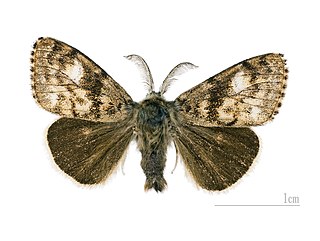Sir George Francis Hampson, 10th Baronet was a British entomologist.

Nepticulidae is a family of very small moths with a worldwide distribution. They are characterised by eyecaps over the eyes. These pigmy moths or midget moths, as they are commonly known, include the smallest of all living moths, with a wingspan that can be as little as 3 mm in the case of the European pigmy sorrel moth, but more usually 3.5–10 mm. The wings of adult moths are narrow and lanceolate, sometimes with metallic markings, and with the venation very simplified compared to most other moths.

Eupterotidae is a family of insects in the order Lepidoptera with more than 300 described species.
Urodidae or "false burnet moths" is a family of insects in the lepidopteran order, representing its own superfamily, Urodoidea, with three genera, one of which, Wockia, occurs in Europe.
Copromorphoidea, the "fruitworm moths" is a superfamily of insects in the lepidopteran order. These moths are small to medium-sized and are broad-winged bearing some resemblance to the superfamilies Tortricoidea and Immoidea. The antennae are often "pectinate" especially in males, and many species of these well camouflaged moths bear raised tufts of scales on the wings and a specialised fringe of scales at the base of the hindwing sometimes in females only; there are a number of other structural characteristics. The position of this superfamily is not certain, but it has been placed in the natural group of "Apoditrysia" "Obtectomera", rather than with the superfamilies Alucitoidea or Epermenioidea within which it has sometimes previously been placed, on the grounds that shared larval and pupal characteristics of these groups have probably evolved independently. It has been suggested that the division into two families should be abandoned.
Agathiphaga is a genus of moths in the family Agathiphagidae, known as kauri moths. This caddis fly-like lineage of primitive moths was first reported by Lionel Jack Dumbleton in 1952, as a new genus of Micropterigidae.

Akodon spegazzinii, also known as Spegazzini's akodont or Spegazzini's grass mouse, is a rodent in the genus Akodon found in northwestern Argentina. It occurs in grassland and forest at 400 to 3,500 m above sea level. After the species was first named in 1897, several other names were given to various populations now included in A. spegazzinii. They are now all recognized as part of a single, widespread and variable species. Akodon spegazzinii is related to Akodon boliviensis and other members of the A. boliviensis species group. It reproduces year-round. Because it is widely distributed and common, Akodon spegazzinii is listed as "least concern" on the IUCN Red List.

Akodon caenosus is a rodent in the genus Akodon found in northwestern Argentina and south-central Bolivia. Since its description in 1918, it has been alternatively classified as a separate species or a subspecies of Akodon lutescens. The species Akodon aliquantulus, described from some very small Argentine specimens in 1999, is now recognized as a synonym of A. caenosus.
Gardinia is a genus of moth in the family Erebidae.

The Thyatirinae are a subfamily of the moth family Drepanidae with about 200 species described. Until recently, most classifications treated this group as a separate family called Thyatiridae.
Neohelvibotys is a genus of moths of the family Crambidae.
Pseudoligostigma is a genus of moths of the family Crambidae.
Pseudepicorsia is a genus of moths of the family Crambidae.
Eois boliviensis is a moth in the family Geometridae. It is found in Bolivia.
Gardinia anopla is a moth of the family Erebidae. It was described by Hering in 1925. It is found in Arizona.
Gardinia magnifica is a moth of the family Erebidae. It was described by Francis Walker in 1865. It is found in Panama, Colombia and Ecuador.
Gardinia amynitica is a moth of the family Erebidae. It was described by Hering in 1925. It is found in Peru.
Gardinia paradoxa is a moth of the family Erebidae. It was described by Hering in 1925. It is found in Peru.







